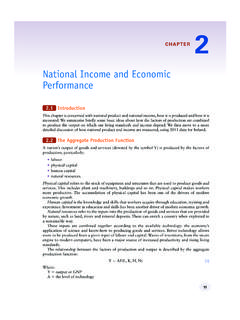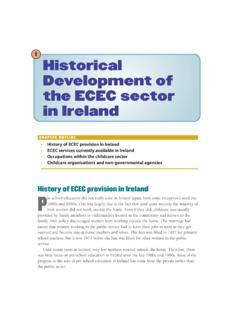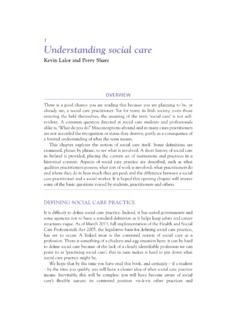Transcription of The Context of Special Needs in Ireland
1 Chapter one The Context of Special Needs in Ireland This book is aimed primarily at students working towards a Special Needs qualifi- cation that will make them more employable as Special Needs assistants (SNAs) in Irish schools and for those providing respite care for children with Special Needs in the children s own homes. defINITIoNS of Special NeedAll children have Needs , physical, safety and security, love and belonging, praise and encouragement. Children with Special Needs have these same Needs together with some additional ones. Special Needs can be defined or categorised in many different ways. They are often categorised according to how frequently they occur in the general population, or else according to the area of development affected by the Special need.
2 Classification according to frequency of occurrence High incidence Special Needs : These are Special Needs that occur relatively frequently in the general population. They tend to be less severe in that the child s overall development is not usually as severely affected by the Special need as children with low incidence Special Needs . Examples of high incidence Special Needs are borderline general learning disability and dyslexia. Usually children with high incidence Special Needs do not receive many additional chapter outline Definitions of Special need Models of disability History of Special Needs service provision in Irelandassisting children with Special 129/07/2013 09:352 ASSISTINg CHIldReN WITH Special NeedSresources, they are not usually eligible for an SNA, but instead receive additional learning support hours.
3 Low incidence Special Needs : These are Special Needs that occur infre- quently in the general population. They tend to be severe in nature in that the child s overall development is often highly affected by the Special need. Examples of low incidence Special Needs are autism, moderate or severe learn- ing disability, syndromes such as Down s syndrome and physical conditions such as cerebral palsy or muscular dystrophy. In general, children with low incidence Special Needs require considerable additional resources, such as a Special Needs assistant, resource teaching hours, speech therapy and physio- therapy and they may be educated outside the mainstream school system.
4 For the purpose of allocation of resources and services, the Department of Education and Science classifies Special Needs as codes No. Category of Special education need Incidence 1 physical disability low 2 hearing impairment low 3 visual impairment low 4 emotional disturbance low 5 severe emotional disturbance low 6 Borderline general learning disability high 7 Mild general learning disability high 8 Moderate general learning disability low 9 severe/profound general learning disability low 10 autism/autistic spectrum disorders low 11 specific learning disability high 12 assessed syndrome low 13 specific speech and language disorder low 14 Multiple disabilities low assisting children with Special 229/07/2013 09.
5 353 The Context of Special Needs in IrelandClassification according to the area of development predominately affected by the Special need Physical health and development: Epilepsy Sickle cell anaemia diabetes Asthma Dyspraxia (difficulty with motor co-ordination) Dysgraphia (difficulty with handwriting) Visual impairment Disability resulting from accidental injury Cystic fibrosis Spina bifida Hydrocephalus Muscular dystrophy Cerebral palsy HIV and AIDS Intellectual or cognitive development: Borderline general learning disability Mild general learning disability Moderate general learning disability Severe or profound learning disability Specific learning disability, dyscalculia Language and communication: Hearing impairment Specific speech and language disorder Dyslexia Newcomer children whose first language is not English assisting children with Special 329/07/2013 09:354 ASSISTINg CHIldReN WITH Special NeedSEmotional and social development: Emotional problems Oppositional defiant disorder Conduct disorder Attention deficit hyperactivity disorder Complex conditions and syndromes (affect more than one area of development).
6 Autistic spectrum disorders Down s syndrome Fragile X syndrome Sometimes children will have multiple Special Needs , a child with ADHD may also have dyslexia and oppositional defiant disorder. In addition, children who are exceptionally able are also recognised under the Education Act 1988 as having Special Needs . ModelS of dISABIlITY There are two main models or ways of looking at disability: the medical model and the social model. Medical model of disability As the name suggests, with the medical model of disability, the focus is on the causes and symptoms of the disability and on its treatment. While this model does have its uses and advantages, the person is seen by this model as abnormal and remains so until the condition is cured.
7 Many disabilities have no cure, so this model of disability can often have a negative effect on the person s self-image and self-esteem. With the medical model, the problem is seen to lie with the person with the disability, so for example, a deaf person should learn to lip read because not many people know sign language. Social model of disability The social model of disability focuses on the environment in which the disabled person lives. With this model of disability, the environment should be adapted to meet the Needs of the disabled person, not the other way around. For example, assisting children with Special 429/07/2013 09:355 The Context of Special Needs in Irelandconsider someone who uses a wheelchair.
8 They are perfectly able to enter buildings, cross roads, travel along footpaths and drive if their environment facilitates them to do so with ramps, lifts and hand-operated cars. This model of disability does not label people as abnormal and is therefore much more respectful of people with disabilities. HISToRY of Special Needs SeRvICe PRovISIoN IN Ireland Swan (2000) described the progression of Special Needs education in Ireland in three phases: the era of neglect and denial, the era of the Special school and the era of integration or inclusion. Under English rule, the National Education System was established in 1831, making school attendance compulsory for all children between the ages of six and 14.
9 By 1892, children had to attend at least 150 days of school each year (today, the primary school year is 183 days). The government did not consider that the edu- cation of children with Special Needs was necessary in that their Needs were seen as purely medical. Many children with Special Needs lived in hospitals, asylums and county homes. However, some religious-run Special schools were established at this time. For example, St Mary s School for Deaf Girls in Cabra, Dublin, was established in 1846 by the Dominican order, St Joseph s School for Deaf Boys in Cabra was established in 1857 by the Christian Brothers and St Joseph s School for the Blind was established by the Carmelite order in 1884 in Drumcondra, Dublin.
10 Children from all over the country boarded in these schools from young ages. From the foundation of the state in 1919 to the early 1990s, practically all edu- cation and care, including the education and care of children with Special Needs , was carried out by the religious orders in Ireland . As a result, there was very little government policy or legislation regarding Special Needs provision in Ireland . The situation remained largely the same until the numbers of religious in Ireland began to decline rapidly and many of the schools and institutions formally run by them were taken over by the state. This, together with an increasing awareness among parents, teachers and other professionals of how our Special Needs provision had fallen badly behind that of other nations, resulted in a relatively rapid change in government policy and the introduction of a number of new important pieces of legislation.









